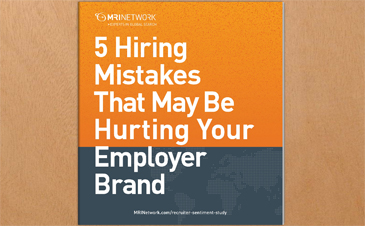Throughout 2016, despite some contractions in the labor market, hiring has continued to increase. Within the last 12 months through April, an average of 232,000 new jobs has been added each month. Many companies are focused on expanding, but are finding it difficult to locate enough skilled talent, especially in the executive, managerial and professional job market. In this sector, which is candidate-driven, employers continue to lose great candidates who are accepting other job offers. So as a hiring authority, what key mistakes could you be making that might be damaging your employer brand?
The 2016 Recruiter and Employer Sentiment Study conducted byMRINetwork, reveals that the inability to find quality talent coincides with lengthy hiring practices, lower than expected compensation, and the failure of prospective employers to sell their brand, the role and advancement opportunities. Retention is also challenging, as high performers recognize more jobs are available and feel more confident about pursuing them.
Based on the Study findings, the following mistakes may be hurting employer brands:
Mistake #1: Not recognizing the implications of a candidate-driven market.
According to the survey, 86 percent of recruiters and 62 percent employers agree the professional labor market is candidate-driven in most industry sectors. The best candidates have other job options, so your value proposition must clearly articulate how coming on board would benefit their career. Assuming that candidates should feel lucky to be invited for an interview with your company is probably the biggest mistake of all. Focus on providing a streamlined and positive interview process that keeps applicants informed of where they stand every step of the way. Most importantly, be sure that everyone on the interviewing team provides consistent messaging about the role and clearly articulates why your company culture and values make it an enviable place to work.
Mistake #2: Believing that compensation is the top deciding factor for high performers who are looking to make a job move.
Forty-nine percent of employers believe competitive salary is what’s most attractive to candidates about their organizations. Seventy-two percent of recruiters say the top deciding factor for a job move is advancement opportunities. While compensation is important to candidates, immediate and long-term advancement opportunities are what drive talent to join a new company, as improved compensation is implied with upward mobility. You need to have real examples to share with candidates regarding how your best employees advanced within the company and how upward mobility is a part of the organization’s culture.
Mistake #3: Deciding that a key strategic hire must always be a permanent employee.
More companies are creating blended workforces that include permanent hires and highly-skilled contract employees. The survey indicates that 63 percent of employers are either offering contract engagements, or are giving more thought to them, based on the level and requirements of the role. Knowing how to attract a contract worker is key. While competitive pay is a starting point, skilled contractors need to be sold on the value their expertise will bring to your project, as well as the potential to be exposed to new technologies, and ways of approaching business that will expand their professional experience. Your recruiter can help you determine when it makes sense to bring on a contractor, and then help you fill and provide back office support for these engagements.
Mistake #4: Making your employer branding and employee engagement strategies a one-dimensional effort.
Bringing on strategic hires is the top focal point for many employers (39 percent). Recruiting is now going beyond the realm of simply finding talent, by executing a more comprehensive array of strategies — both proactive and reactive — that will position companies as employers of choice. As you begin developing these strategies, be sure to include members from all departments. Their insight will help deliver a more well-rounded, targeted approach to employer branding and employee engagement initiatives.
Mistake #5: Requiring that candidates endure at least three interviews.
Fifty percent of employers are frustrated most with the lack of skilled talent in many sectors. While this is a common challenge, hiring authorities need to be able to act quickly when they come across great candidates. Lengthy hiring practices are the main reason companies are unable to keep top candidates engaged, and ultimately get them to accept a job offer. Alternative measures like team interviews where companies ask candidates to participate in routine business exercises such as brainstorming or planning sessions, can provide insight on the applicant’s personality and likelihood of fitting in to the company culture, while reducing the interview process from three to two steps.
When you put these 5 hiring mistakes together, it’s clear how they may be impacting your employer brand and your ability to attract top talent in an already tight candidate market. The hiring landscape and candidate expectations have changed. Companies that want to attract and retain the best talent, will need to revisit their interviewing and talent management approaches, to create a strong employer brand.
To view a summarized overview on hiring mistakes that can be easily distributed to others in your organization responsible for hiring, click here. To view the complete Study, visit MRINetwork.com/Recruiter-Sentiment-Study.
